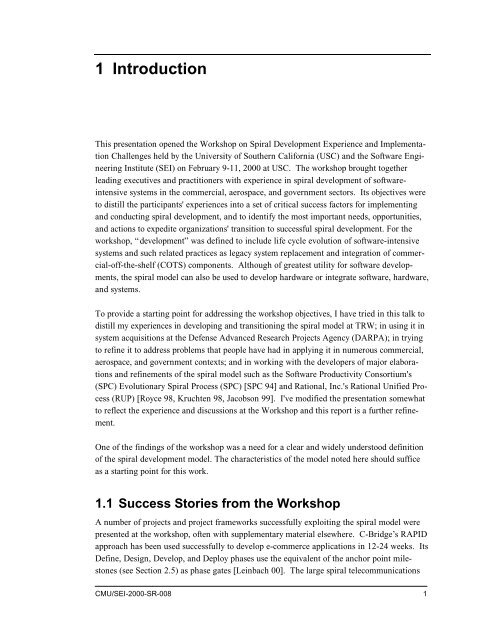00sr008
00sr008
00sr008
You also want an ePaper? Increase the reach of your titles
YUMPU automatically turns print PDFs into web optimized ePapers that Google loves.
1 Introduction<br />
This presentation opened the Workshop on Spiral Development Experience and Implementation<br />
Challenges held by the University of Southern California (USC) and the Software Engineering<br />
Institute (SEI) on February 9-11, 2000 at USC. The workshop brought together<br />
leading executives and practitioners with experience in spiral development of softwareintensive<br />
systems in the commercial, aerospace, and government sectors. Its objectives were<br />
to distill the participants' experiences into a set of critical success factors for implementing<br />
and conducting spiral development, and to identify the most important needs, opportunities,<br />
and actions to expedite organizations' transition to successful spiral development. For the<br />
workshop, “development” was defined to include life cycle evolution of software-intensive<br />
systems and such related practices as legacy system replacement and integration of commercial-off-the-shelf<br />
(COTS) components. Although of greatest utility for software developments,<br />
the spiral model can also be used to develop hardware or integrate software, hardware,<br />
and systems.<br />
To provide a starting point for addressing the workshop objectives, I have tried in this talk to<br />
distill my experiences in developing and transitioning the spiral model at TRW; in using it in<br />
system acquisitions at the Defense Advanced Research Projects Agency (DARPA); in trying<br />
to refine it to address problems that people have had in applying it in numerous commercial,<br />
aerospace, and government contexts; and in working with the developers of major elaborations<br />
and refinements of the spiral model such as the Software Productivity Consortium's<br />
(SPC) Evolutionary Spiral Process (SPC) [SPC 94] and Rational, Inc.'s Rational Unified Process<br />
(RUP) [Royce 98, Kruchten 98, Jacobson 99]. I've modified the presentation somewhat<br />
to reflect the experience and discussions at the Workshop and this report is a further refinement.<br />
One of the findings of the workshop was a need for a clear and widely understood definition<br />
of the spiral development model. The characteristics of the model noted here should suffice<br />
as a starting point for this work.<br />
1.1 Success Stories from the Workshop<br />
A number of projects and project frameworks successfully exploiting the spiral model were<br />
presented at the workshop, often with supplementary material elsewhere. C-Bridge’s RAPID<br />
approach has been used successfully to develop e-commerce applications in 12-24 weeks. Its<br />
Define, Design, Develop, and Deploy phases use the equivalent of the anchor point milestones<br />
(see Section 2.5) as phase gates [Leinbach 00]. The large spiral telecommunications<br />
CMU/SEI-2000-SR-008 1














